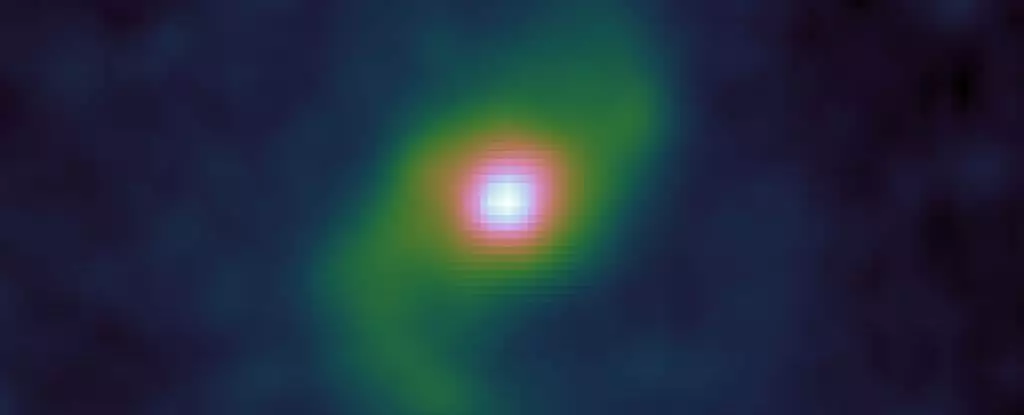The quest to understand the formation and evolution of galaxies remains one of the most captivating challenges in modern astrophysics. Recent discoveries, notably the identification of a colossal spiral galaxy known as J0107a, have added layers of complexity to our understanding. This galaxy, intriguingly formed merely 2.6 billion years after the Big Bang, presents a considerable conundrum for astronomers. What scientists once believed could only emerge over eons now appears strikingly evolved in its structure and function, indicating that the early Universe was teeming with potentially sophisticated cosmic entities.
The Surprising Structure of J0107a
What sets J0107a apart is its remarkably organized structure, especially the existence of a stable galactic bar—a long, ribbon-like formation of stars that runs across its center. This feature is typically indicative of a well-developed galaxy and was thought to emerge only after millions of years of evolutionary processes. As astronomer Shuo Huang from the National Astronomical Observatory of Japan articulates, witnessing such sophisticated architecture so early poses questions about the pace and mechanisms of galactic formation. The very presence of this galactic bar challenges the prevailing narrative that galaxies begin as chaotic mass concentrations that slowly evolve into structured forms.
This revelation raises a fundamental question: How did J0107a form so quickly? The initial assumption was that galaxies gradually built themselves around central black holes, accumulating gas and dust to slowly ignite stellar formations. However, the implications of J0107a suggest that the rapid inflow of gas from the cosmic web may have facilitated a quick transition into a relatively stable galactic form.
The Role of Gas and Star Formation
The study conducted by Huang and his team deployed advanced observations via the James Webb Space Telescope (JWST) and the Atacama Large Millimeter/submillimeter Array (ALMA), shedding light on the gas dynamics within J0107a. They discovered that the galactic bar efficiently channels gas toward the center, at a staggering rate of approximately 600 solar masses per year. This gas flow not only propels the galaxy’s rapid star formation—at a rate that eclipses the activity we observe in mature galaxies like our own Milky Way—but also implies the intricate interplay between gas dynamics and stellar birth.
Remarkably, the increase in gas density at J0107a’s core raises anew the question of how star formation occurs in this early cosmic environment. Is it possible that the conditions here differ radically from those in local galaxies? The denser gas in J0107a could create unique conditions for star formation, potentially leading to populations of stars that diverge significantly from those in more evolved galaxies.
Implications for Galactic Models
The existence of such a well-defined structure in J0107a invites a reconsideration of our current models concerning early galactic development. Traditionally, models have proposed that galaxies would need to endure a series of chaotic events, including interactions and mergers, to reach a stable state. The implications of J0107a, however, are suggestive of a more tranquil evolution, possibly driven by the cosmic web’s gas inflow rather than tumultuous encounters with other celestial bodies.
This paradigm shift is particularly important, as it requires a reassessment of how we define galaxy formation and evolution timelines. If J0107a can achieve a high degree of organization early, what does this mean for our understanding of other galaxies from similar epochs? Future observational studies promise to unravel these mysteries, potentially redefining key phases in the lifecycle of galaxies.
The Future of Astronomical Research
As we turn our gaze to the cosmos, the discovery of J0107a paves the way for groundbreaking observations. Researchers are keenly interested in uncovering how cosmic gas is funneled into forming structures within galaxies. Comprehending the manner in which gas behaves and settles allows astronomers to construct more accurate models of galactic evolution in the early Universe.
With the advanced capabilities of upcoming telescopes, the next wave of studies is poised to provide deeper insights into the intricacies of galaxy formation. Observing how J0107a continues to evolve may reveal patterns and dynamics crucial to understanding not just our galaxy, but the entire Universe’s early architecture. Ultimately, the revelations stemming from discoveries like J0107a compel us to rethink long-held assumptions, inspiring a new era of inquiry in the ever-expanding landscape of astronomy.


Leave a Reply